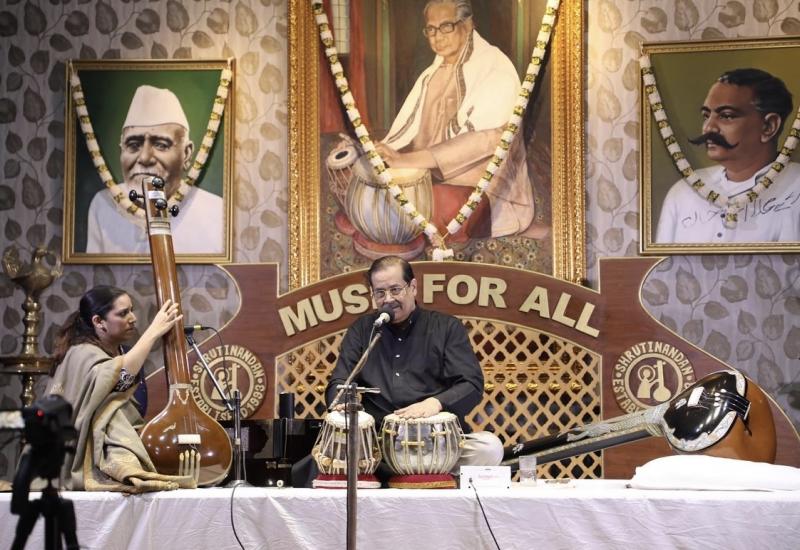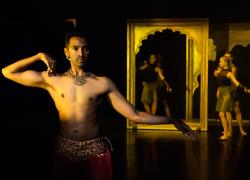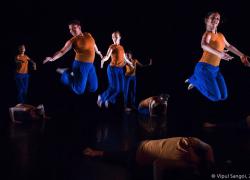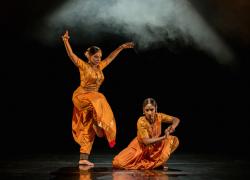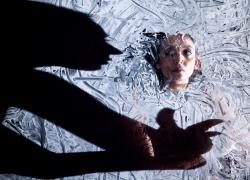Pleasure and Pain – Dancing in the Outdoors
Bharatanatyam dancer and Peak District National Park Ranger Chamu Kuppuswamy tells us of how she is combining her twin passions.
Photos: Credit: Simon Richardson | Location: Michael's Folly, Hertford
What are the pieces you are working on that will be performed outdoors, and why these?
I am working on a Tamil vernacular poem combined with a varnam, to be performed in outdoor locations such as woods, and mountains, and in different seasons. In addition, I have finished a keerthanam,* padam and Bharathi poetry* outdoors, and these have been shot as part of Chinnadevi – A Dance Film.* I have chosen these pieces because I am passionate about understanding and performing bharatanatyam in its traditional creative intent (‘TIC’). My practice is based on understanding TIC, and this has actually led me outdoors. I think TIC is a living evolving entity. My current practice philosophy is that TIC is experiential and is somehow rooted in nature. This is why you will find me passionately pursuing details in the outdoors, as I choreograph and deconstruct the Tevaram* and varnam.
My knowledge of the outdoors as a trained outdoor professional is key to combining my dance with the outdoors. For the past ten years I have been volunteering as a ranger in the Peak District National Park, and have painstakingly been understanding the special landscapes of Britain. My quest to take the margam outdoors is not just to use the outdoors as a ‘stage’. It is much more than that. Eventually it helps me deepen every aspect of my bharatanatyam practice, breathing fresh understanding into the traditional repertoire, having deconstructed it and reconstructed it in the outdoors. Thanks to COVID, all this is happening now.
Tell us more about your exploration underfoot.
The first memory for a bharatanatyam dancer is the strike of a foot. And when I set foot in the outdoors as a dancer, the explosion of tactility underfoot hit me. I had to be safe, but my urge to explore was great. I was dancing barefoot, on rugged ground, but also, on some of the softest of textures I have ever felt underfoot, the moss. It is softer than the softest grass you can think of! There is a rusticity about this whole enterprise, which I feel is reflected in the poetry that I want to explore: the Tamil vernacular poetry of Appar (7th century) and K.N. Dhandayuthapani Pillai’s Tamil varnam on Shiva (20th century), both of which reference Shiva in elemental form.
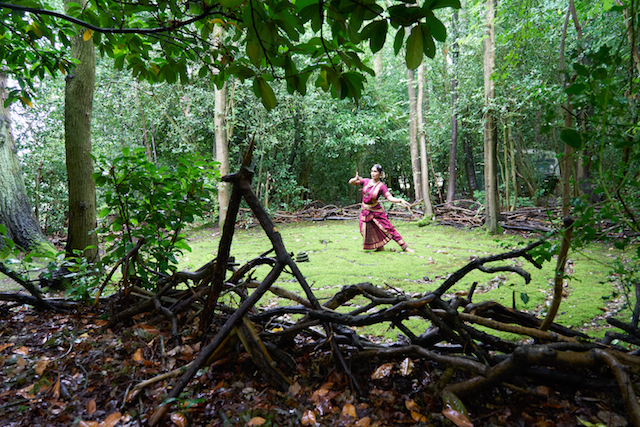
Another underfoot exploration that fascinates is water when it is both underfoot and overfoot – like when you dip your feet in a shallow beck, or stand on a sandy beach as the waves recede on the eroding sands underneath you; or when water has smoothed a surface for years, like the weathered limestone platforms you find in our national parks. And then what happens when what is underfoot, suddenly surrounds you from all around? I mean the underground: just as there is British landscape up above, there is also a vast underground landscape which is completely made up of the earth that we stand on. When I was potholing in the peak district, I was doing a thattu adavu,* striking my foot on muddy soil, but with my head rooted in soil too! The ground was all around me! And the amazing thing about these underground spaces is the existence of pure sound and deep silence; and what’s more is that we have concepts, poems and stories that explore all these worlds in Indian mythology and literature – a great match to explore!
To return to my recent underfoot experience of doing site-specific choreography, of a keerthanam under a large tree. It wasn’t just rough ground underneath my feet: below the rough ground were the roots of this large tree, through which coursed water, and underneath that was more soil. There was a resonance in the ground, which was the result of the immediate surface layer combined with the organic matter below. This multifaceted living surface has a continuum from below the soil through the roots of the tree and up above into the sky through the trunk and the branches.
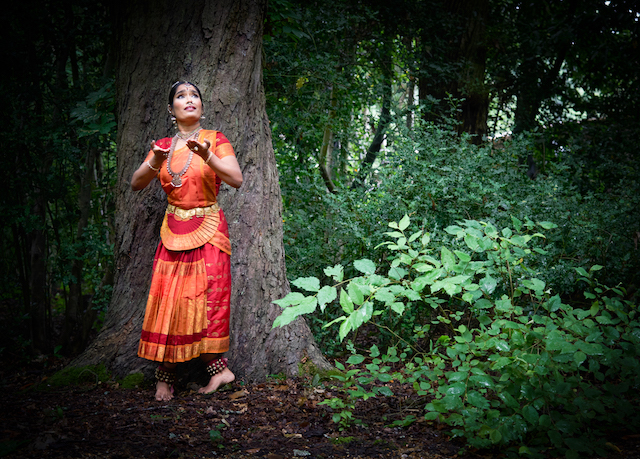
Most bhakti poetry* is like the romantic era poems, combining nature and the human condition. So the Purandaradasa keerthanam I was choreographing below this large tree (Purandaradasa is one of the prime bhakti poets), blossomed through this sophisticated awareness I had of the living space that I was choreographing it in. The ‘gajendra moksham’ episode, involving a crocodile, an elephant, and a giant eagle descending from the skies was real, in terms of the dimensions; and so were the finer details of rocks used to build the bridge by Sri Rama. I was there, standing on tiny stones, looking and imagining. The outdoors takes the dancer’s imagination to a deeper level – I found that I was putting mind over matter. We do this as dancers anyway, with strenuous routines testing us, but the outdoors brings a transcendence. A similar awareness, but a different feeling spreads with a different surface, such as moss, for example.
On a more technical level, I was becoming aware of the sole of my foot as an upanga, a minor part of the human body. The underfoot became a discrete upanga. It is not one of the twelve upangas mentioned in the Natyashastra – the Natyashastra is mainly focussed on the minor parts of the face such as the eyebrows, jaws, and tongue – there is even a mention of eye balls and gums!
I became aware of how exactly I was placing my foot in the process of dancing; how much of the sides of my feet I was using, how much pressure I gave on the arches, and how it did or didn’t sink down. As I danced for longer and longer, I became acutely aware of the edges and tops of my toes and the space in between my toes, and the use of the heel and the ankle.
I am now becoming an expert in how to choose the surface underfoot from amongst the infinite variety found in a natural environment. One can also respond to the seasons, or the micro season in that region. The possibilities seem endless. Nature sites are living and breathing sites – as we well realised at the shoot, when the tree we were filming under shed two of its magnificent branches, weighing half a tonne or so, right where we were filming. If I hadn’t gauged the sound of the cracking branches correctly, I would have come to some severe damage pinned down by a horse chestnut branch!
How do you think about costumes and colours in these contexts?
Strong colours work really well. I think of colours and costumes in a holistic way. It is not just about wearing an orange amidst all the green, although this is great! What is important for me is how I come to it, and this could lead to some stunning combinations. I look at the not-so-obvious, or the generally unnoticed, in the environment: the colour of the forest floor when a light shower has fallen on the leaf litter that is dry and fading after being beaten down by the summer heat. What is that colour? A lovely browny maroon. So I chose to stop at this spot and explore when I wear a maroon costume. The visuals take on a different quality and depth when holistically thinking of the environment and the costume colours. Sometimes it is straightforward, blue in a snowy white, though I’ve yet to try this out in wintery conditions.
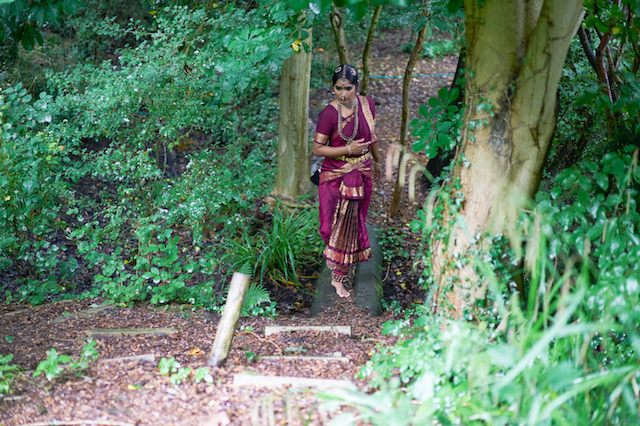
The bharatanatyam costume is of complex design, and so is nature, so they play out well in each other’s company. The unfurling of folded fabric in a typical bharatanatyam costume, like the fronds of an ornamental palm, with its golden designs, probably of flowers and leaves and swans or birds, provide the sophistication, matched by nature. The dynamic movement possible with such sophisticated costumes is also enhanced by the movement one gets in a natural setting.
I am keen to experiment with glow-in-the-dark clothing in a dark skies area. Brecon Beacons National Park and Northumberland National Park have International Dark Skies status, which means there is little light pollution there. Now, for a visual art such as bharatanatyam, you might think, what could one do in the dark? A lot really, from the sound made by our own feet, to our bells, our clothes, and the music we use!
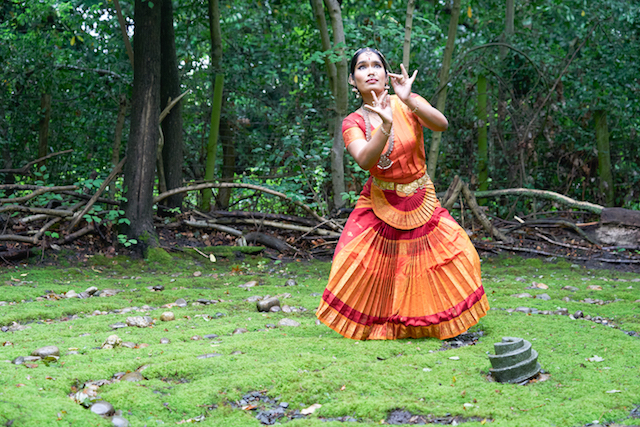
How does the environment shape your movement?
You said it! The environment has shapes, and this sculpts the space. A lot of the macro movements are shaped by the shapes of nature – the straight length of a tree or the curvatures of a rock, or the slant of the rays of the sun through the trees and so on. The quality of the natural object is the next shaper of movement – the hardness, the thinness, the grandness. In the British landscape, a lot of the big natural objects are rooted. This quality resonates with the earth-bound nature of most bharatanatyam movements.
A lot of the micro movements are shaped by the dynamism in nature – the leaves moving the wind, the fluttering butterfly, or the damselfly by the stream, or its rippling clear waters, gurgling over loose stones in the bed, these are reflected in the facial expressions. The face is the site for most of the interesting micro movements in bharatanatyam: a twitch of the eyebrows or the eyes shifting, the lips in action, a frown or a smile in response to movements in nature. And in the keerthanam I was choreographing, by Purandaradasa, the foremost of Bhakti poets, there was a conceptual harmony between the outdoor space and in the words of the poetry:
Mahalakshmi, whom would you marry?
Sri Rama, the bridge builder?
Or the one who reclines on the mighty snake (Ananta Padmanabha)?
Or him who resides on the land between the two rivers?
Or the majestic king of the herders?
In this manner, Purandaradasa recites the names of eighteen different versions of Vishnu, most having connections with nature and the world outdoors.
The environment induces depth in the spontaneity of the micro movements. One also needs to have a broad repertoire of pieces in one’s kitty, in order to be able to choose the right way to intersect with nature with our poems. I chose to take up the padam "Chaliye kunjanu mo’ by the 19th-century composer Swati Tirunal. In this piece, the words indicate the outdoors numerous times. I am on the front foot already with such a piece.
How do you respond musically to the outdoors?
The outdoors has a lot of sounds, it’s music to my ears! At the same time, there are spaces in nature with deep silence. Singing there would be an experience! Down below in the bowels of the earth, there is silence. As Arthur Conan Doyle once said, ‘All this country is hollow, could you strike it with some gigantic hammer it would boom like a drum.’ What imagination! I have been to some awe-inspiring natural spaces in the peak and lake district, where the cave walls rise up like a cathedral, to create the most amazing acoustics. A friend of mine organised a choir in one such space! And in there, the periodic drop of a water droplet breaking the silence, falling onto an underground pool, was magical! If I could use this to create a soundscape… The sound of the drop, the sound of my ankle bells, a symphony in movement and sound!
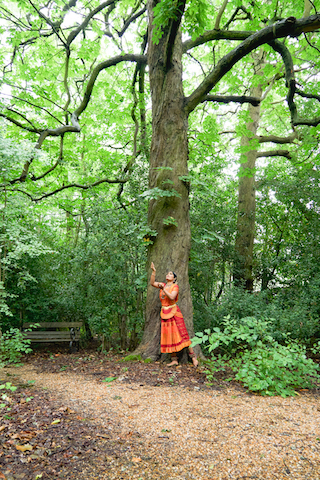
So, you see that I aim to integrate with nature sounds. My knowledge of the outdoors about what sound to find where and when will be key to the experimentation. In the Tevaram-varnam choreography, my process will be to walk with the instrumentalist to experience the woods, and the stream, to find spaces to open up musically, and to see how it evolves.
Integrating music with sounds and words is the final layer. You can also have the wrong sound! When I was doing ‘Chaliye kunjan mo’, and came to the words which went Suniye koyal (cuckoo)… a wood pigeon croaked up above me! The wrong place at the wrong time!
NOTES
*Keerthanam: A dance item with a good measure of lyrical and expressive content and some pure movement.
*Tevaram – Devotional poetry from the 7th and 8th centuries, held in very high esteem by the Tamils.
*Thattu adavu – First series of dance movements, literally meaning striking of the foot. It forms an integral part of the training of a Bharatanatyam dancer.
*Bharathi – Subramania Bharathi is a 20th century poet and key personality in the Indian freedom movement in South India, he is known for his fiery Tamil writing that inspired poular patriotism. His poetry is deeply reflective of the political as well as the spiritual.
*Chinnadevi – The first three performances were live (see the Narthaki review of the premiere in Bangalore), but with COVID-19 intervening right in the middle of the touring schedule, I turned the inability to perform live into an opportunity to learn about film. The live show has been substantially adapted for film. While the touring show was all indoors, the film is very much – 75% – in the outdoors. Essentially the idea of presenting margam pieces through a linked story context, for the whole 100 or so minutes, still remains in Chinnadevi- A Dance Film.
Bhakti poetry: Devotional and ecstatic poetry.
Look out for the release of Chinnadevi – The Film on the 14th of November 2020.
The Tevaram is currently in the creative phase, after having been through R and D and will be ready at the end of 2021.
Chamu Kuppuswamy, Michael's Folly, Hertford | Credit Simon Richardson












